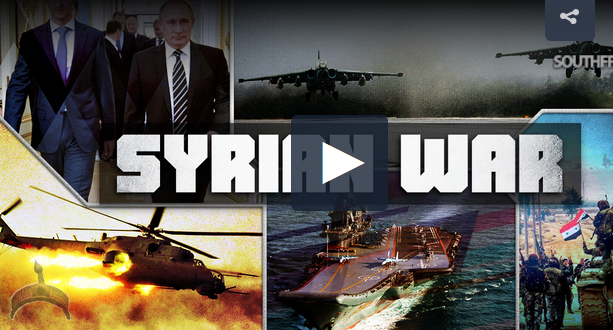Obviously, Moscow had to expand its own military infrastructure at the facilities in Tartus and the Khmeimim airbase, and to ensure the security of the deployed forces. Russian attack helicopters additionally used airbases in Shayrat, Homs, Tiyas and Damascus as advance airfields. As a beneficial consequence of direct participation in the conflict, the Russian Federation gained the opportunity to test its more modern weapons systems under real combat conditions and to provide personnel with combat experience. Even tough Russia was employing a relatively small combined task force to achieve the aforementioned goals throughout the course of the operation, this force of soldiers, battle hardened and educated on the modern field of battle, would provide a core cadre full of invaluable experience and leadership.
Air Forces
When the operation started, the Russian Aerospace Forces deployed at least 50 aircraft, including Su-24M attack aircraft, Su-25SM attack aircraft, Su-30SM fighter jets, Su-34 fighter-bombers and Mi-24 attack helicopters with transport capabilities and Mi-8 military transport helicopters. This air group was reshuffled several times depending upon the situation on the ground and the tasks and objectives pursued by the Russian leadership. At different stages of the conflict, it also included Su-35S multi-role air superiority fighters, Su-27SM multirole fighters, MiG-29SMT air superiority fighters and Ka-52 and Mi-28N attack helicopters. Tu-160, Tu-95MS and Tu-22M3 strategic bombers were employed from airfields in southern Russia.
Two Su-57 fifth generation stealth fighter jets passed combat tests in Syria in February 2018. According to the Russian Defense Ministry, at least one Su-57 used an advanced air-launched cruise missile to target militants. The decision was recently made to approve the first serial production run of twelve of these advanced aircraft.
A deeply modernized Su-25SM3 attack aircraft, which incorporates the Vitebsk-25 EW system, avionics, and weapon control systems with an L-370-3S digital active jamming station, was also spotted at the Khmeimim airbase. The L-370-3S can use an enemy radar emission to locate their azimuth and determine the radar emission type, as well as suppress the signal in different frequency ranges. It also possesses protective measures against various missiles.
The A-50 airborne early warning and control aircraft, Il-20M1 electronic, radar reconnaissance aircraft and Tu-214R electronic surveillance aircraft were another component of the Russian “reconnaissance-strike complex” keeping control of Syrian airspace and detecting troop and supply movements on the ground as well as locating militant commanders, headquarters, weapon depots and other key infrastructure by detecting their electronic communications’ signature an locating its source. Russia has been developing a number of advanced electronic warfare, surveillance and command and control aircraft over the past two decades.
On a tactical level, Russian servicemen used a high number [about 100] of unmanned aerial vehicles (UAVs) of different types; Orlan 10, Forpost, Orion, Dozor-100, Eleron-3, and the Pchela-1T to conduct reconnaissance during combat operations and to monitor ceasefire areas across the country.
Units of the Naval Infantry, the Mechanized Infantry, the Special Operations Forces and the Military Police have provided strong zonal security for the Khmeimim and Tartus infrastructure from the very start of operations. Particularly, servicemen of the 810th Naval Infantry Brigade of the Black Sea Fleet have been involved in this task. T-90 main battle tanks have been also deployed to bolster the security posture of these forces in very real terms.
Air Defense
The Russian military has significantly increased air defense capabilities of its grouping deployed in Syria after a Turkish F-16 fighter jet shot down a Russian Su-24 warplane near the Syrian-Turkish border on November 24, 2015. This incident forced Russia to deploy its advanced S-400 long-range air defense systems to protect its facilities and forces. Russian forces in Syria are also protected by the following systems:
- S-300V4 anti-ballistic missile system
- Tor M2 surface-to-air missile system
- Buk-M2E self-propelled, medium-range surface-to-air missile system
- Osa highly mobile, low-altitude, short-range tactical surface-to-air missile system
- S-125 Pechora 2M surface-to-air missile system
- Pantsir-S1 self-propelled combined short to medium range surface-to-air missile and anti-aircraft artillery weapon system
Krasukha-4 and other electronic warfare systems are also an important component of the Russian forces’ air defense capabilities. According to some experts, these systems were employed during two US-led missile strikes on Syrian government forces in 2017 and 2018, and were likely an important factor behind the questionable success of these US attacks.
Additional air-defense capabilities have been provided by the Russian naval task group deployed in eastern Mediterranean. These capabilities depend on the composition of the group. For example, the Slava class guided missile cruisers Moskva and Varyag, which have been deployed as part of such task groups in the past, are equipped with the S-300F Fort long-range surface-to-air missile system.
Naval Forces
The naval task group deployed also increased the anti-ship capabilities of the Russian operational force in Syria, allowing it to protect itself from hostile warships. In November 2016, the Russian military officially announced that it sent K-300P Bastion-P mobile coastal defense missile systems to Syria. This anti-ship missile system is designed to engage surface ships, including carrier strike groups, convoys and amphibious assault ships.
The Russian naval force involved in the conflict was in its strongest shape in the period of November 2016 to January 2017 when the Kirov class nuclear-powered battlecruiser Pyotr Velikiy, heavy aircraft-carrying missile cruiser Admiral Kuznetsov and two Udaloy class anti-submarine destroyers were deployed along with a number of smaller support vessels. This group significantly expanded air-defense, anti-ship and anti-submarine capabilities of the Russian forces. Mig-29KR/KUBR and Su-33 jets attached to the Admiral Kuznetsov also took part in the aerial operation against militants in the country, carrying out 420 combat missions and hitting 1,252 targets, according to the Russian Defense Ministry. On the other hand, Admiral Kuznetsov’s air wing lost a MiG-29K jet and a Su-33 jet during the Syria deployment, because of technical faults during the aircraft arrested-recovery process. This highlighted problems and limitations of the Russian naval aviation at its current stage of development and maturity. Importantly, the most valuable asset involved in both of these accidents, the pilots, were rescued by the vigilant recovery teams of the naval task force.
Warships of the Black Sea Fleet and the Caspian Sea Fleet also participated in the campaign carrying out Kalibr cruise missile strikes on ISIS and Jabhat al-Nusra targets, mainly weapon depots, headquarters, and other high value, hardened targets. Although western mainstream media tried to downplay the significance of Kalibr cruise missile strikes from both surface warfare vessels and submerged submarines, these attacks very clearly illustrated the success of the Russian defense industry in producing high tech cruise missiles, as well as the Russian military’s proficiency at utilizing them.
 Ọmọ Oòduà Naija Gist | News From Nigeria | Entertainment gist Nigeria|Networking|News.. Visit for Nigeria breaking news , Nigerian Movies , Naija music , Jobs In Nigeria , Naija News , Nollywood, Gist and more
Ọmọ Oòduà Naija Gist | News From Nigeria | Entertainment gist Nigeria|Networking|News.. Visit for Nigeria breaking news , Nigerian Movies , Naija music , Jobs In Nigeria , Naija News , Nollywood, Gist and more








